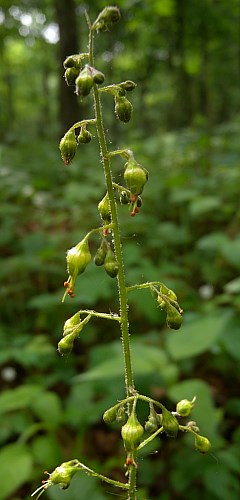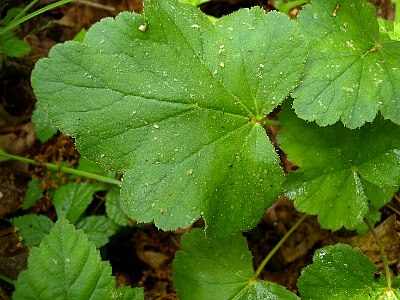 Description:
This herbaceous perennial plant consists of a large tuft of basal
leaves up
to ½' tall, from which one or more flowering stalks develop that are
2–3½' tall. The blades of the basal leaves are 2½–4" across. They are
more or less orbicular in overall shape, but with 5-9 lobes along their
margins; these lobes are shallow and rounded. The blades are indented
at the junction of the petioles, while their margins are coarsely
crenate-dentate. The upper surfaces of the leaf blades are medium green
and sometimes variegated; they have scattered short hairs and a rough
texture. The slender petioles are light green and hairy; they are as
long or longer than their blades. The tall flowering stalks are light
green, terete, hairy, and without leaves. At the apex of each stalk,
there is a narrow panicle of flowers about 3-8" long. The spreading
branches of the panicle are light green and hairy, while the flowers
are drooping. Each fully developed flower is 4.0–4.5 mm. long,
consisting of a light green or reddish green calyx with 5 narrow lobes,
5 light green petals, 5 strongly exerted stamens with orange-red
anthers, and 2 styles. The petals are smaller than the calyx and
insignificant. The calyx is conspicuously swollen toward its base. The
blooming period occurs from late spring to early summer and lasts about
3 weeks. There is no noticeable floral scent. Each flower is replaced
by a small seed capsule that has 2 prominent beaks. There are numerous
tiny seeds inside each capsule, which are small enough to be blown
about by the wind. The root system consists of a crown with fibrous
roots. The preceding description applies only to var.
hirsuticaulis.
Description:
This herbaceous perennial plant consists of a large tuft of basal
leaves up
to ½' tall, from which one or more flowering stalks develop that are
2–3½' tall. The blades of the basal leaves are 2½–4" across. They are
more or less orbicular in overall shape, but with 5-9 lobes along their
margins; these lobes are shallow and rounded. The blades are indented
at the junction of the petioles, while their margins are coarsely
crenate-dentate. The upper surfaces of the leaf blades are medium green
and sometimes variegated; they have scattered short hairs and a rough
texture. The slender petioles are light green and hairy; they are as
long or longer than their blades. The tall flowering stalks are light
green, terete, hairy, and without leaves. At the apex of each stalk,
there is a narrow panicle of flowers about 3-8" long. The spreading
branches of the panicle are light green and hairy, while the flowers
are drooping. Each fully developed flower is 4.0–4.5 mm. long,
consisting of a light green or reddish green calyx with 5 narrow lobes,
5 light green petals, 5 strongly exerted stamens with orange-red
anthers, and 2 styles. The petals are smaller than the calyx and
insignificant. The calyx is conspicuously swollen toward its base. The
blooming period occurs from late spring to early summer and lasts about
3 weeks. There is no noticeable floral scent. Each flower is replaced
by a small seed capsule that has 2 prominent beaks. There are numerous
tiny seeds inside each capsule, which are small enough to be blown
about by the wind. The root system consists of a crown with fibrous
roots. The preceding description applies only to var.
hirsuticaulis.
Cultivation:
The preference is dappled sunlight during the spring, followed by light
shade during the summer. The soil should be well-drained, mesic to dry,
and loamy or rocky. This is primarily a foliage plant that can function
as a ground cover if it is densely planted.
Range & Habitat:
The native Woodland Alumroot is occasional in the southern half of
Illinois, while
in the northern half of the state it is rare or absent (see Distribution
Map). Habitats include upland rocky woodlands, thinly wooded
bluffs, and wooded slopes. This species is found in high quality
habitats where oak trees are often present. The most commonly
encountered variety of Woodland Alumroot within the state is var.
hirsuticaulis.
Faunal Associations:
The nectar and pollen of the flowers attract small bees, including
Halictid bees (Halictus spp., Lasioglossum spp., &
Augochlorella spp.) and the oligolectic Plasterer bee Colletes
aestivalis. This latter bee is a specialist pollinator of Heuchera
spp. Insects that prefer to feed on the foliage or juices of Heuchera
spp. include the flea beetle Altica heucherae
and the aphid Nasonovia heucherae. The
bitter-tasting basal leaves are usually ignored by mammalian herbivores.

Photographic
Location:
An upland rocky woodland at the Portland Arch in west-central Indiana.
Comments:
Woodland Alumroot and other native Heuchera spp.
are related to the commonly cultivated 'Coral Bells' of horticulture.
However, the flowers of the native species are usually green and less
showy. Across its range, different varieties of Woodland Alumroot have
been identified. Compared to the typical variety, the variety that has
been described here (var. hirsuticaulis) has flowering stalks and
petioles that are more hairy. Otherwise, they are very similar. Another
variety that has been recognized in Illinois, var. interior,
has smaller flowers (3.0–3.5 mm. long) than var. hirsuticaulis.
Another species in this genus that is sometimes encountered within the
state is Heuchera richardsonii (Prairie Alumroot).
It differs from the preceding varieties of Woodland Alumroot by its
longer asymmetrical flowers (5.0–9.0 mm.). The flowers of Woodland
Alumroot are more symmetrical (one side of the flower is about as long
as another side).